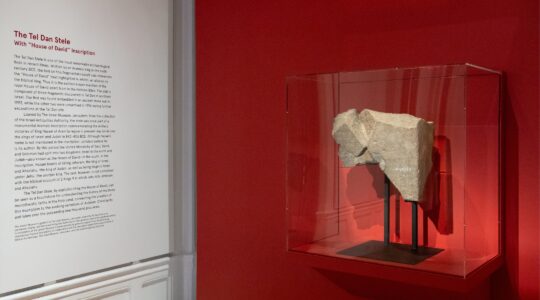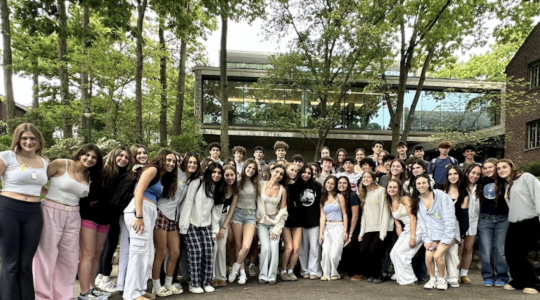Some were born in the former Soviet Union, and came to the United States as children with their families. Some were born to émigré families here. Typical of Jews who grew up in households where education about Judaism was minimal, they had learned little about fundamental Jewish beliefs.
Including tzedakah.
A few weeks ago a dozen of them started their remedial education.
Seated around a long table in the conference room of the Jewish Child Care Association’s Bukharian Teen Lounge in Forest Hills, the young men and women, most of them in their 20s, attended the first 2012-13 meeting of Kalontar, a leadership training program launched five years ago under JCCA auspices. They were flanked by a huge TV screen, wall-mounted subway maps, and computer terminals that ring the room. Bella Zelkin, JCCA’s Minsk-born director of émigré services who established Kalontar — the name means “leaders” in Bukharian — started the meeting with a discussion of Jewish identity. She was setting the tone for a year-long exploration of Jewish history, Jewish values, the grant-making process, the function of nonprofit agencies, and the organization of the American Jewish community.
Then she introduced tzedakah. She talked about the role of Jewish-American philanthropists who had brought them — future Jewish leaders of Bukharian descent — as well as past waves of Jewish immigrants, to this country. She mentioned that, as part of their training, the Kalontar members would take part in Super Sunday in a few months.
A hand in the back of the room went up.
“What does mean ‘Super Sunday?’” one man asked.
Zelkin explained that Super Sunday is one of the major community-wide fund-raising events conducted annually by UJA-Federation of New York, with hundreds of volunteers of all ages participating in the phone-a-thon.
The man’s question, she said, was proof that Kalontar’s work is needed. “For many of them” — the members of émigré families — “our project is their first experience” with what tzedakah is on a wide-scale basis and how it is carried out, she said. “The concept is new.”
“The Russian Jewish community is fairly new to the concept of tzedakah and charitable giving,” says Esther Lamm. A native of Lvov, she heads UJA-Federation’s Russian Leadership Division, which emphasizes tzedakah in all its activities. “We recognize that our community, although it has been successful and does give back [in terms of charity], needs to be educated on what this means and the importance of being … involved in the [wider] Jewish community.”
Immigrants from the former Soviet Union aren’t the only ones now learning about tzedakah in a formal manner. A small-but-growing number of Jewish organizations are developing extensive curricula and other educational programs to teach a practice of Judaism that was taken for granted a few generations ago. American Jewish World Service, which organizes volunteers’ social justice work around the world, issued its first tzedakah curriculum, a 99-page document titled “Where Do You Give?” this summer, and the Jewish Teen Foundations of the Marin/San Francisco Jewish federation has received recognition for its array of tzedakah training with high school-age students.
At one time, says tzedakah maven Danny Siegel, whose Ziv Tzedakah Fund collected (mostly from donors of small amounts) and distributed (mostly to recipients in the U.S. and Israel) more than $10 million, no one needed to educate Jews here about the precepts of giving; they saw it at home, in religious school, in synagogue.
Support the New York Jewish Week
Our nonprofit newsroom depends on readers like you. Make a donation now to support independent Jewish journalism in New York.
Within a few generations, Siegel says, “tzedakah and gemilut chesed [the doing of good deeds] were assimilated out” of many American Jews. “They’re a part of [Jewish] life that disappeared.”
Lisa Exler, senior program officer of AJWS and lead author of its tzedakah curriculum, disagrees.
“American Jews are generous contributors and have more options for giving tzedakah than ever before, requiring them to make choices about where to give,” she says of the AJWS initiative. “We hope to help people be more thoughtful and intentional about giving, so that their contributions reflect their values and respond to real need. By engaging people in thinking about where to give, we hope to inspire them to increase how much they give.”
The new educational initiatives are helping to restore the prominent position of tzedakah in American Jewish life, Siegel says. “There are more and more people teaching tzedakah than there were 10 years ago.”
Siegel and other people involved in tzedakah-education efforts stress that tzedakah (the word, usually translated as “charity,” comes from the Hebrew root for “righteousness”), means more than money. It’s also time – one can contribute one’s energies.
The AJWS curriculum, edited by Exler and offered as a pilot program last year at two Brooklyn schools (Congregation Beth Elohimn, and the Hannah Senesh Community Day School), was designed as part of a national competition last year; contestants were asked to create a tzedakah box that “reflects the complexities of 21st-century giving,” and to spark a national conversation about tzedakah. The curriculum is geared for middle school students, in grades six through eight.
“First, middle school students are in a critical period of identity formation, when integrating the values behind their tzedakah-giving can have long-term effects on their giving as adults,” the curriculum’s introduction states. “Second, in the context of becoming bnai mitzvah, middle school students are likely to receive money and, often for the first time, are able to make decisions about how much and where to give.”
The AJWS curriculum, funded by the Jim Joseph Foundation, includes text study, discussion questions, lesson plans and homework assignments. Its “primary goal,” according to the introduction, “is to educate students to be more thoughtful and intentional tzedakah-givers.” Its message, says Stephanie Ives, director of community engagement, is “Don’t give tens of dollars, or hundreds of dollars without thought.”
“People aren’t careful” about how they give, Exler says. “The next generation of tzedakah givers will be better givers of tzedakah.”
One of the first-such tzedakah curricula was “Tsedakah and Us,” written nearly three decades ago for Clal – The National Jewish Center for Learning and Leadership, by Rabbi Reuven Kimelman, a long-time Brandeis University faculty member. It offers the perspective of those who give, those who solicit gifts and those who allocate the money raised.
Under Siegel’s leadership, a curriculum on tzedakah and “mitzvah heroes” was issued in 1998, written by Rabbi Steven Bayar of Millburn, N.J. “To Fix the World – Stick Your Neck Out,” the curriculum published by Siegel’s Ziv Tzedakah Fund and Giraffe Project, contains more than three dozen chapters and focuses on such topics as feeding the hungry, respecting one’s elders and “Guarding the Earth.”
“Remember that our tradition teaches that actions lead to belief,” the introduction states. In the tzedakah chapter, people are encouraged to consider what they can forego to enable someone else to eat; to create a “loose change depository” in each congregation; to implement collection drives for hats or gloves or other “specific” items; and to identify stories and ads about “some sort of Tzedakah work” in local newspapers.
Support the New York Jewish Week
Our nonprofit newsroom depends on readers like you. Make a donation now to support independent Jewish journalism in New York.
UJA-Federation’s Russian Leadership Division, says Esther Lamm, emphasizes to its young professional members that “tzedakah is not an option but actually an obligation.” Its Russian Chai society, in which participants pledge at least $18 a month to the philanthropy’s annual campaign, bills itself as “the first step for young philanthropists to get involved” with UJA-Federation.
Like the Russian Leadership Division, Kalontar has no formal curriculum; rather, it offers a series of workshops and lectures and other activities.
The recent opening meeting attracted a cross section of young professionals and blue-collar workers. One of them, Arthur Yusupov, a 33-year-old native of Uzbekistan, says he is “interested in educating people” about tzedakah. A corporate trainer who lives in Briarwood, Queens, he says that Kalontar has already taught him “a lot – that tzedakah is one of the pillars of Judaism.”
Yusupov calls himself typical of his generation of Russian-speaking émigrés. “A lot of my friends are interested” in tzedakah, but don’t know the basics.
Past Kalontar participants have become active supporters of several local Jewish organizations, including Hillel and UJA-Federation, and some have started their own foundations to help needy children, Zelkin says.
She points to Levi Rachmanov, a 24-year-old native of Tajikistan, who was part of Kalontar last year. A vice president of investments at the Blackwall Capital Markets, he formed his own charitable foundation (tr-charitable-foundation.org; the TR stands for “The Rachmanov”) two years ago. Its chief activity is buying and distributing 125 backpacks, full of school supplies, to area Jewish and non-Jewish homeless students at the start of the school year.
He first thought of forming his own foundation by 2030, when he expects to be more financially settled. Then he thought again. “Why do it in 2030? Why can’t I do it now?”
Rachmanov says Kalontar helped him fine-tune his philanthropic instincts. “They should have more and more groups like this.”
His next goal: a book drive for under-financed libraries. “My long-term vision is to give back.”
Kalontar’s schedule of monthly meetings is being drawn up now.
“We will be talking about philanthropy in the United States,” Zelkin says. “These sessions should take place prior to the Super Sunday event,” which is held every year the week following the NFL’s Super Bowl championship game.
No one in Kalontar will ask what Super Sunday is when the year ends, Zelkin says. “By the end of the program they will know.”
Support the New York Jewish Week
Our nonprofit newsroom depends on readers like you. Make a donation now to support independent Jewish journalism in New York.
The New York Jewish Week brings you the stories behind the headlines, keeping you connected to Jewish life in New York. Help sustain the reporting you trust by donating today.




